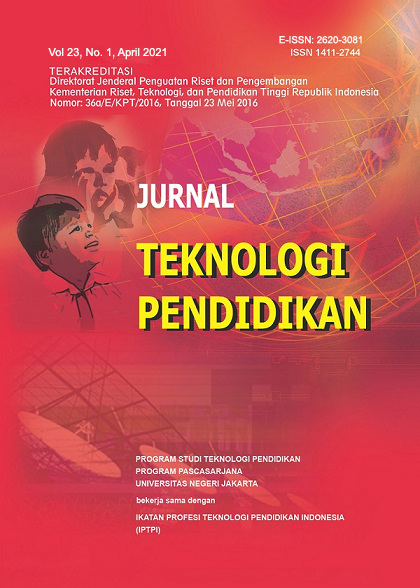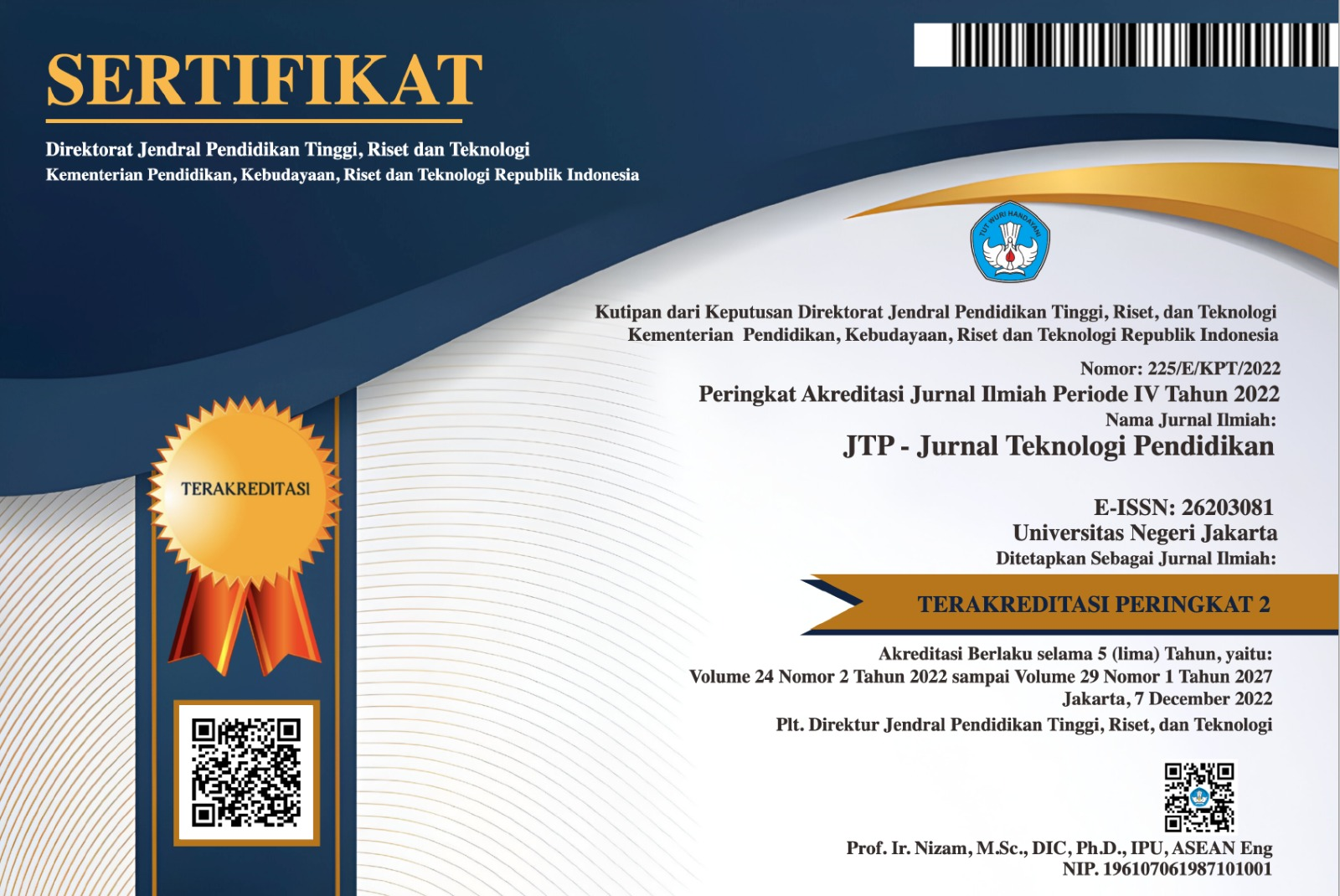Development of Multimedia Interactive Learning of Hydrosphere Material for High School
DOI:
https://doi.org/10.21009/jtp.v23i1.18579Keywords:
Research development, learning interactive multimedia, Hydrosphere, geography.Abstract
The purpose of this research is the development of learning interactive multimedia at hydrosphere subject matter class X of high School. The development research which aims to produce learning interactive multimedia on subjects geography which is valid, practical and effective against the learning outcomes of students. Research development was using the Alessi and Trollip models. The steps of its developers, namely, planning, design, and development. On the stage of the alpha test do the validation on the validator I, validator II, and validator III. Test phase implemented in the class X IPS B SMA Muhammadiyah 6 Palembang. Data collection techniques using interviews, questionnaires, and tests. This research is valid and deserves to be tested after going through the process of validation of the validator I, validator II, and validator III. Through the beta test results the practicality shows the average value of 92,3 to the category of “very practical”. At the stage of field test learning outcomes of students showed an increase which amounted to 56,6 with the average results of the pretest of 24.6, while the posttest results amounted to 81,2 with N-gain of 0.75 then it belongs to the category of high, this shows that the learning interactive multimedia that is developed has a value of valid, practical, effectiveness and worth to use.
References
Alessi, S. M., & Trollip, S. R. (2001). Multimedia for learning methods and development. Boston: Allyn and Bacon, Inc.
Barron, A. B., Hebets, E. A., Cleland, T. A,. Fitzpatrick, C. L,. Hauber, M. E., & Stevens, J. R. (2015).Embracing multiple definitions of learning. Journal of Trends in Neurosciences. 38(7):405-407. https://doi.org/10.1016/j.tins.2015.04.008
Çelik., Özer. & Altunaydin.,S.,S. (2018). A Research on Machine Learning Methods and Its Applications. Journal of Educational Technology & Online Learning. 1(3): 25-40. DOI: 10.31681\jetol.457046
Miarso, Y. (2015). Menyemai benih teknologi pendidikan. Jakarta: Kencana Prenanda Media Group.
Nazir, M. I. J., Rizvi, A. H., & Pujeri, R. V. (2012). Skill development in multimedia based learning environment in higher education: an operational model. International Journal of Information and Communication Technology Research, 2(11).
Nihei, S. Shabazz, R. & Matriano. A.,E. (2017). Effectiveness of Using Teacher-Made Interactive Multimedia Materials in Teaching Geography To Tourism Students. 10th International Conference on Arts, Social Sciences, Humanities and Interdisciplinary Studies (ASSHIS-17). 45-48. https://doi.org/10.17758/URUAE.UH1217411
Nugroho, P.A., Raharjo, T. & Wahyuningsih, D. (2013). Pengembangan Media Pembelajaran Fisika Menggunakan Permainan Ular Tangga Ditinjau Dari Motivasi Belajar Peserta didik Kelas VIII Materi Gaya. Jurnal Pendidikan Fisika. 1 (1): 11-18.
Prismanata, Yoga,. & Ismaniati, Crhistina. (2017). Pengembangan Multimedia Pembelajaran Geografi Berbasis Memory Sport Pada Materi Litosfer Untuk Peserta Didik SMA. Jurnal Inovasi Teknologi Pendidikan. 4(1) : 97-110. https://doi.org/10.21831/jitp.v4i1.11621
Permendikbud. Nomor 68 Tahun 2013. Tentang Kerangka Dasar Dan Struktur Kurikulum.
Rachmadtullah, R., Zulela, Ms. & Sumantri, M.,S. (2018). Development of computer-based interactive multimedia : study on learning in elementary education. International Journal of Engineering & Technology. 7 (4): 2051-2054. DOI: 10.14419/ijet.v7i4.16384
Siahaan, SM. (2012). Penggunaan Teknologi Informasi dan Komunikasi Dalam Pembelajaran Fisika. Prosiding Seminar Nasional Fisika. Prosiding Seminar Nasional Fisika,13-20. Palembenag Universitas Sriwijaya. Program Studi Pendidikan Fisika dan Program Magister Teknologi Pendidikan, Universitas Sriwijaya.
Sidh, S.,M & Saleem, H,.N (2013). Interactive Multimedia Cognitive Mind Mapping Approach in Learning Geography. Multimedia Technology (MT). 2(2):9-17 https://www.researchgate.net/publication/273632327_Interactive_Multimedia_Cognitive_Mind_Mapping_Approach_in_Learning_Geography
Uno, B,.H & Ma’ruf, K,.R. (2016). Pengembangan Media Pembelajaran IPS Berbasis Website untuk Peserta didik Kelas VII Madrasah Tsanawiyah Negeri. Jurnal Teknologi Pendidikan. 18(3): 169-185. https://doi.org/10.21009/jtp.v18i3.5372
Vaugan, T. (2011) Multimedia: making it work. Eighth Edition. New York: Technology Education Mac Graw Hill.
Yaumi, M. (2013). Prinsip-Prinsip Desain Pembelajaran. Jakarta: Kencana.
Downloads
Published
How to Cite
Issue
Section
License
Jurnal Teknologi Pendidikan is an Open Access Journal. The authors who publish the manuscript in Jurnal Teknologi Pendidikan agree to the following terms.
Attribution-ShareAlike 4.0 International (CC BY-SA 4.0)
-
Attribution — You must give appropriate credit, provide a link to the license, and indicate if changes were made. You may do so in any reasonable manner, but not in any way that suggests the licensor endorses you or your use.
-
ShareAlike — If you remix, transform, or build upon the material, you must distribute your contributions under the same license as the original.
- No additional restrictions — You may not apply legal terms or technological measures that legally restrict others from doing anything the license permits.
Notices:
- You do not have to comply with the license for elements of the material in the public domain or where your use is permitted by an applicable exception or limitation.
- No warranties are given. The license may not give you all of the permissions necessary for your intended use. For example, other rights such as publicity, privacy, or moral rights may limit how you use the material.








